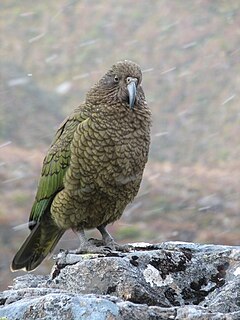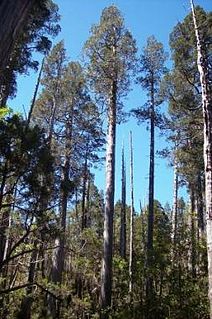
Kiwi or kiwis are flightless birds native to New Zealand, in the genus Apteryx and family Apterygidae. Approximately the size of a domestic chicken, kiwi are by far the smallest living ratites.

Moa were nine species of now-extinct flightless birds endemic to New Zealand. The two largest species, Dinornis robustus and Dinornis novaezelandiae, reached about 3.6 m (12 ft) in height with neck outstretched, and weighed about 230 kg (510 lb). It is estimated that, when Polynesians settled New Zealand circa 1280, the moa population was about 58,000.

The Haast's eagle is an extinct species of eagle that once lived in the South Island of New Zealand, commonly accepted to be the Pouakai of Maori legend. The species was the largest eagle known to have existed. Its massive size is explained as an evolutionary response to the size of its prey, the flightless moa, the largest of which could weigh 230 kg (510 lb). Haast's eagle became extinct around 1400, after the moa were hunted to extinction by the first Māori.

This article relates to the flora of New Zealand, especially indigenous strains. New Zealand's geographical isolation has meant the country has developed a unique variety of native flora. However, human migration has led to the importation of many other plants as well as widespread damage to the indigenous flora, especially after the advent of European colonisation, due to the combined efforts of farmers and specialised societies dedicated to importing European plants & animals.

The biodiversity of New Zealand, a large island nation located in the southwestern Pacific Ocean, is varied and distinctive accumulated over many millions of years as lineages evolved in the local circumstances. New Zealand's pre-human biodiversity exhibited high levels of species endemism, but has experienced episodes of biological turnover. Global extinction approximately 65 Ma ago resulted in the loss of fauna such as dinosaurs, pterosaurs and marine reptiles e.g. mosasaurs, elasmosaurs and plesiosaurs. The ancient fauna is not well known, but at least one species of terrestrial mammal existed in New Zealand around 19 Ma ago. For at least several Ma before the arrival of human and commensal species, the islands had no terrestrial mammals except for bats and seals, the main component of the terrestrial fauna being insects and birds. Recently—since c. 1300 CE—a component has been introduced by humans, including many terrestrial mammals.

The conservation status of a group of organisms indicates whether the group still exists and how likely the group is to become extinct in the near future. Many factors are taken into account when assessing conservation status: not simply the number of individuals remaining, but the overall increase or decrease in the population over time, breeding success rates, and known threats. Various systems of conservation status exist and are in use at international, multi-country, national and local levels as well as for consumer use.

New Zealand is a sovereign island country in the southwestern Pacific Ocean. The country geographically comprises two main landmasses—the North Island, and the South Island —and around 600 smaller islands. New Zealand is situated some 2,000 kilometres (1,200 mi) east of Australia across the Tasman Sea and roughly 1,000 kilometres (600 mi) south of the Pacific island areas of New Caledonia, Fiji, and Tonga. Because of its remoteness, it was one of the last lands to be settled by humans. During its long period of isolation, New Zealand developed a distinct biodiversity of animal, fungal, and plant life. The country's varied topography and its sharp mountain peaks, such as the Southern Alps, owe much to the tectonic uplift of land and volcanic eruptions. New Zealand's capital city is Wellington, while its most populous city is Auckland.

Gradungulidae is a spider family endemic to Australia and New Zealand with 16 species in seven genera. They are medium to large-sized three-clawed haplogyne spiders with two pairs of book-lungs.

The Orsolobidae are a six-eyed spider family with about 180 described species in 29 genera. They were separated from the Dysderidae. Several genera were transferred from the Oonopidae.

The Cyatholipidae are a spider family with 58 described species in 23 genera.

Cycloctenidae is a spider family with 36 described species in 5 genera. The genera Plectophanes, Toxopsiella and Uzakia are all endemic to New Zealand, Cycloctenus is found in both Australia and New Zealand, while Galliena is endemic to Java. The placements of Galliena, Plectophanes and Uzakia in Cycloctenidae are tentative only.

McMillan's catshark is a catshark of the family Scyliorhinidae, in the order Carcharhiniformes. McMillan's cat shark is a small, rare and little-known deepwater shark. It is endemic to New Zealand. This species is found in the deep waters of the lower continental slope around New Zealand, on the West Norfolk Ridge and off North Cape. This species can be found at depths of 985-1350m. It can grow up to a length of 45 cm.

The white-bodied catshark is a catshark of the family Scyliorhinidae.

The flaccid catshark is a catshark of the family Scyliorhinidae. It is endemic to the waters around New Zealand.
Arthur William Baden Powell was a New Zealand malacologist, naturalist and palaeontologist, a major influence in the study and classification of New Zealand molluscs through much of the 20th century. He was known to his friends and family by his third name, "Baden".

The birds of New Zealand evolved into an avifauna that included a large number of endemic species. As an island archipelago New Zealand accumulated bird diversity and when Captain James Cook arrived in the 1770s he noted that the bird song was deafening. The mix includes species with unusual biology such as the kakapo which is the world's only flightless, nocturnal, lek breeding parrot, but also many species that are similar to neighboring land areas. A process of colonization, speciation and extinction has been at play over many millions of years, including recent times. Some species have arrived in human recorded history while other arrived before but are little changed.

The Antarctic Floristic Kingdom, also the Holantarctic Kingdom, is a floristic kingdom. It includes most areas of the world south of 40°S latitude. It was first identified by botanist Ronald Good, and later by Armen Takhtajan. The Antarctic Floristic Kingdom is a classification in phytogeography, different from the Antarctic ecozone classification in biogeography, and from Antarctic flora genera/species classifications in botany.

Henry Suter was a Swiss-born New Zealand zoologist, naturalist, palaeontologist, and malacologist.

The New Zealand Threat Classification System is used by the Department of Conservation to assess conservation priorities of species in New Zealand.
Megadictynidae is a family of araneomorph spiders endemic to New Zealand.



















